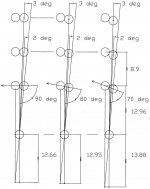I'm sorry John, but your explanations didn't really answer my question. I still don't know how to measure increased pocketing percentages or tremendously increased confidence, or any of the other intangibles that a player might claim they benefited from once they started using CTE. I'm looking for improvements through the use of CTE that can actually be measured. The reason I need that is so I can put a value to it in the form of money. Why? Because it's already been proven in these threads that CTE is far too complex to try and explain to novice players, so its true value must be with advanced players and professionals. And what is it that these players use to track their success rate? Money.
Let me give you an example of what I mean: Suppose a player is making $20,000 a year just off of his/her game (no other sources of income counted). Now suppose a CTE instructor tells this player that he/she could increase their pocketing percentage by 10% (a HUGE supposition since this person must already be a very skilled player). Further suppose that the 10% increase in pocketing percentage could be directly transferable to winnings in tournaments or gambling (another HUGE supposition). What would the real value be? It would be $2,000, of course. Would that be enough value to this player after considering the time and money investments involved in learning CTE? Who knows, except the player? Many players might decide that more practice time, using their current aiming methods, would yield greater values.
As far as the intangible benefits (values) go; you had a point with the increased confidence thing, John. I remember years ago when I bought a beautiful new cue at a tournament in N.C. from Joe Blackburn (built by him). I then drove the 700 miles home and immediately jumped into a tough 9-ball tournament without ever hitting a ball with that cue. I won that tournament, and I firmly believe it was because of the increased confidence I gained from owning a new cue. And I know for a fact that CTE had nothing to do with it.

Will we ever reach a point where we can put some measurable values on CTE?
I apologize in advance if this post is off track, Dave.
Roger
